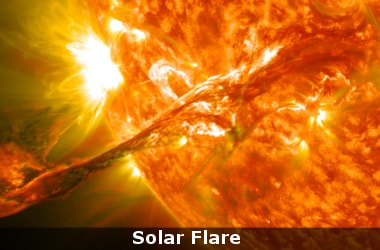
OUR Sun has sent forth seven flares in seven days. One is headed our way.
One, unleashed last week, was the solar equivalent of Hurricane Irma - a monster X9.3 storm.
Even though it only struck Earth a glancing blow, this was enough to disrupt some radio communications.
Since then, the same cauldron of magnetic activity on the Sun’s surface has erupted with flare after flare.
Another big one, at magnitude X8.2, was blasted outwards overnight. It’s arriving soon.
An X8.2 class solar flare flashes in the edge of the Sun on September 10, 2017.
This image was captured by NASA's Solar Dynamics Observatory and shows a blend of light from the 171 and 335 angstrom wavelengths.
An X8.2 class solar flare flashes in the edge of the Sun on September 10, 2017.
What makes these flares so significant is that the explosions have been strong enough to tear pieces of the Sun away from itself, and fling it into space.
It’s called a coronal mass ejection (CME), and - depending on its strength - if one was to hit Earth the effects could range from an annoyance to catastrophic.
The latest warning from the Space Weather Prediction Center is that the latest flare could cause a moderate disruption radio communications over North and South America for up to an hour tonight.
While the Earth’s atmosphere protects those of us on the surface from the most harmful rays, things get different the higher up you go.
The Sun is supposed to be approaching solar minimum - a period where hardly a ripple marks its surface.
But observations over the centuries have shown that when a solar ‘hot spot’ does emerge at this time, it tends to be very hot. It’s times like these that have produced some of the biggest solar flares recorded.
The X9.3 flare was the largest flare so far in the current solar cycle, the approximately 11-year-cycle during which the sun’s activity waxes and wanes.
The current solar cycle began in December 2008, and is now decreasing in intensity and heading toward solar minimum. This is a phase when such eruptions on the sun are increasingly rare, but history has shown that they can nonetheless be intense.
Solar Flare: Know More- The first impact from a solar flare comes from charged particles travelling at 150,000,000km/h.
These arrive at Earth about an hour after an eruption. - But the bulk of the material spewed forth by a CME can take a couple of days to reach our planet - giving us time to prepare.
- Solar flares can be a serious threat.
- The biggest blobs of energy - if they were to strike Earth full-on - charge the ionosphere, causing it to absorb radio waves. This could cut communications with everything from airliners to satellites - including GPS signals.
- Radiation levels in space would also spike, posing a health risk to astronauts aboard the International Space Station and even airline passengers.
- The most severe geomagnetic storms could pump unwanted electrical current into power lines, and even electrical devices. These have been known to fry electrical networks, blacking out entire cities and states.
Blackouts From Solar Flares- In 1989, the entire Canadian state of Quebec was blacked out for nine hours after a direct hit from a coronal mass ejection.
- Another 200 power grids in the United States experienced surges.
- The worst was in 1859, when electricity was only beginning to be used in telegraph wires. These failed worldwide.
- A similar hit, now, could be an electronics apocalypse - taking out power networks and destroying electronic systems such as banking transactions.
- It would be a worldwide disaster, with transportation and food production networks crippled.
- The current solar hotspot, dubbed Active Region 2673, was first spotted on August 29.
- This flare is likely to be the last to have any impact on Earth as the region is rotating towards the Sun’s far side.